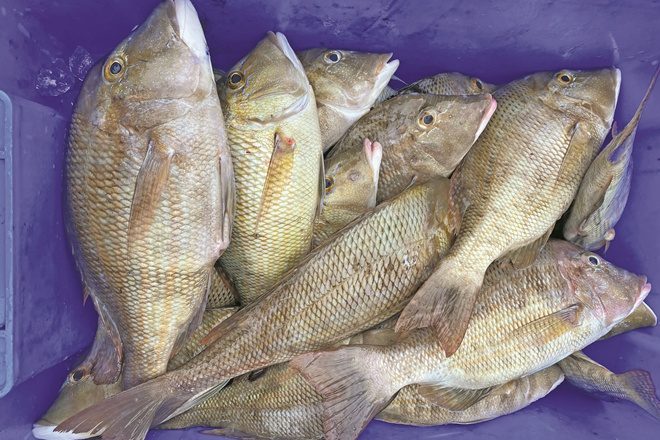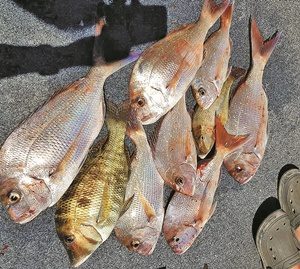
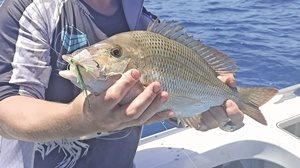
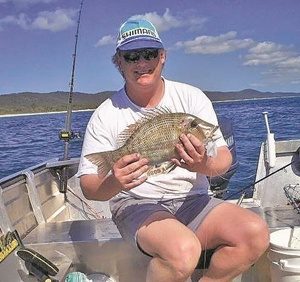
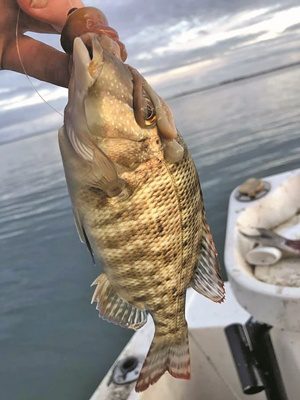



MORETON Bay holds heaps of shallow water areas. When we fish the shallows, we look for rubble patches and any other good-looking structure that holds bait on a high tide. What that means is you fish the shallows on a high tide and retreat to the drop-offs on a low tide. Moreton grassie
Peak bite times are dawn and dusk, as these periods allow you to pull quality fish in shallow water of up to 2m deep. As the sun rises higher and the tide drops, it is time to move to deeper water. When fishing shallow water, it is important to minimise sound, such as banging through the hull and excessive anchor noise.
A tip to eliminate anchor noise is to put bicycle tube over the chain. We will generally drift across structure, as anchoring is a sure way to turn off the fish. If you have an electric motor, even better – the slower the drift the more fish you will catch. Use light spin gear with quality reels, as sticky drags equals pulled hooks. Moreton grassie
We start with 10lb braid and 12lb leader, but if we find nasty looking structure with plenty of bait or we get dusted, then we up the braid to 15lb with 15lb leader – using no more than size 2-3 octopus or circle hooks when using bait. A few of the better shallow areas are Mud, Peel, Green and Coochiemudlo islands, the Wellington Point drop-offs, Scarborough Reef and the edges of the shipping channel from Bulwer north towards Caloundra.
This last area holds a lot of coffee rock structure along the side of the channel and also produces spangled emperor and tuskfish, plus the usual snapper. There are a range of plastics that suit this style of fishing. If targeting sweetlip, size 2-3 hooks are about the biggest you want to use. From our time on the water it seems cod and snapper prefer gold colours and naturals, while lippers prefer bright colours.Moreton grassie
Grass sweetlip are the primary target fish, with 1-2kg being common and the odd 2-3kg fish turning up – more often than not smoking you. Remember sweetlip have a legal size of 30cm and limit of 10 per person. When casting plastics, allow it to hit the bottom and then give it a sharp rip up off the bottom. This allows the lure to drop back to the bottom as you wind the slack up, but hold it off the bottom for a few seconds.
Most hits will come on the drop or on the pause and it is important to watch your line. If the line speeds up, twitches or stops, chances are a fish has it in their mouth, so wind, strike and set the hook. First light is a prime time to target sweetlip and they generally bite well for the first half hour of light after the sun comes over Stradbroke and Moreton islands.Moreton grassie
It pays to be at your location early, with the boat positioned and ready to go for this peak bite period. Dusk is a great time for sweetlip and one advantage to an afternoon session is that it gives you time to look around the area and get set for the last hours of light when sweetlip tend to fire up. During summer we get the high temperature and humidity, two things that turn sweetlip on.
Artificial reefs and wrecks are fantastic structure for holding sweetlip. Locate schools of bait on your sounder when searching around and you will generally be in with a good chance of bagging a few. The better plastics are the paddle tails with a fish-shaped body – plastics similar to the Z-Man 2-3” MinnowZ. The Z-Man versions have a super-lively action and are a versatile option when targeting sweetlip or even snapper in shallow water.
It pays to carry a wide variety of jig heads when fishing for sweetlip, though these fish are often caught using squid heads or strips using a lightly weighted or unweighted, with size 2-3 circles. The same applies to jig heads and plastics too – light weights are best – this allows your plastic to naturally fall through the top half of the water column.Moreton grassie
It is also important to match your jig head hook size to your soft plastic – as a general rule, the shank of the hook, excluding the weight, should be about a third of the length of your chosen plastic. Scent is a good means of attracting sweetlip, so adding Pro-Cure gel to your plastics can make the difference between landing a few fish and missing out.
A lot of the Z-Man plastics have a belly slot, which is perfect for inserting a good dollop of smelly stuff. The reason I use the Z-Man range is that they are 10x tougher than standard plastics, and there are a lot of pickers down below that will make short work of weaker soft plastics. Sweetlip prefer the lure on the bottom, so once the plastic touches down, hop it a few times before you retrieve it.Moreton grassie
This method can also be used with bait too. When retrieving the plastic from the bottom we use a ‘rip-rip-pause’, then wind a few metres, pause and free spool the line back before retrieving the lure back to the boat. Sweetlip will often follow the lure up off the bottom and then whack it as it comes back to them.Moreton grassie
Having a couple of rods and reel outfits on board when chasing shallow water sweetlip is certainly an advantage, as bite periods generally come in short stints and there is nothing more frustrating than having to re-tie during a hot bite period. I keep a 7’ spin rod with a 2500 size spin reel spooled with 10lb braid and 12lb flurocarbon leader, and another 7’ spin rod with 3000 size spin reel spooled with 15lb braid and 15lb leader.
So, go out and explore the shallow water and find areas or structure to fish when the tide and bite time are not in your favour.
 Bush 'n Beach Fishing Magazine Location reports & tips for fishing, boating, camping, kayaking, 4WDing in Queensland and Northern NSW
Bush 'n Beach Fishing Magazine Location reports & tips for fishing, boating, camping, kayaking, 4WDing in Queensland and Northern NSW
